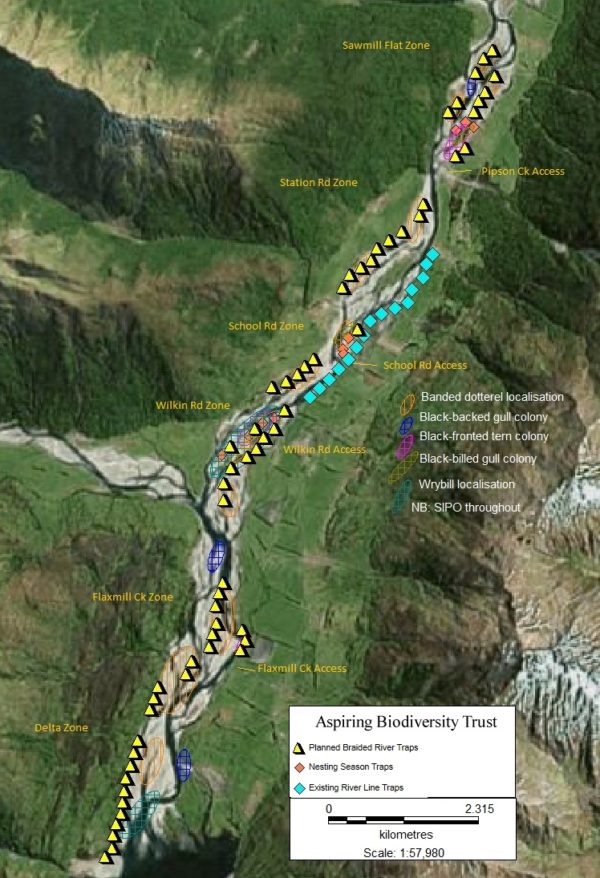Makarora River (& Wilkin River confluence at the delta)
With a surface catchment area of 73,200 hectares, the headwaters of the 35km long Makarora River (interactive catchment map) are in the Otago Region’s Mount Aspiring National Park on the eastern flanks of the Main Divide (Southern Alps) near Haast Pass, the saddle between the Makarora and Haast River valleys. The river flows south into the northern end of Lake Wanaka, 300m above sea level, after passing the small community of Makarora. Braiding of the river begins at Boiler Flat, approximately 304m above sea level and flows south-west joining the Blue and the Young Rivers, then extending its braid plain further meeting its confluence with the Wilkin River, continuing to the Lake Wanaka delta. The riverbed is typical of braided rivers in the South Island, containing multiple channels with islands of gravel between them, on which birds nest.
Biodiversity
Five threatened endemic braided river bird species; black-fronted tern, black-billed gull,banded dotterel, wrybill, and South Island pied oystercatcher depend on this braided river habitat to complete their life cycle. These species have unique adaptive survival strategies such as cryptic coloration and multiple brood production to allow survival and reproduction within this often-harsh environment.
Conservation activities
See: Aspiring Biodiversity Trust
From the ‘Makarora Braided River Bird Survey 2017’ (Report 3.4Mb PDF plus Addendum Report for the delta): An update braided river bird walkover survey was undertaken during October 2017 with subsequent nest monitoring during November 2017.
Nesting colonies of black-billed gull and black-fronted tern were identified. Evidence of breeding (i.e. eggs, chicks observed) wrybill, banded dotterel and South Island pied oystercatcher was recorded.
Nesting colonies of Southern black-backed gull were also recorded within close proximity to breeding braided river birds. A natural native predator of endemic braided river birds.
Rising river levels early November caused flash flooding resulting in the loss of black-billed gull nests, eggs and chicks and the loss of black-fronted tern nests and eggs. Both colonies have now re-established alternative nesting sites.
Survey results indicate that the Makarora River remains an important site for indigenous braided river birds, maintaining a diverse and complete braided river avifauna. Following this survey work, an initial ten invasive mammal predator traps have been deployed within the braided river environment.

Bird counts

References & Research
- LAWA interactive map and detailed data from monitored sites in the catchment
- See Rivers for a more comprehesive list of braided rivers research and reference material
- DOC catalogue of scientific publications: enter the relevant search terms in the ‘search’ dialogue box. You may need to vary your search, for example ‘black stilt’ gives far more results than ‘kaki’ or ‘kakī’
- Otago Regional Council: managing our environment
